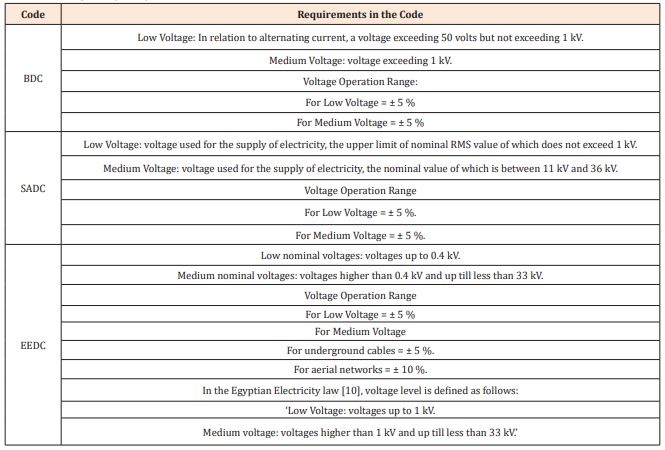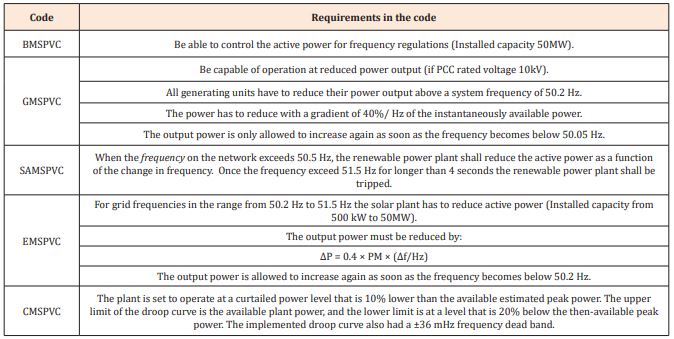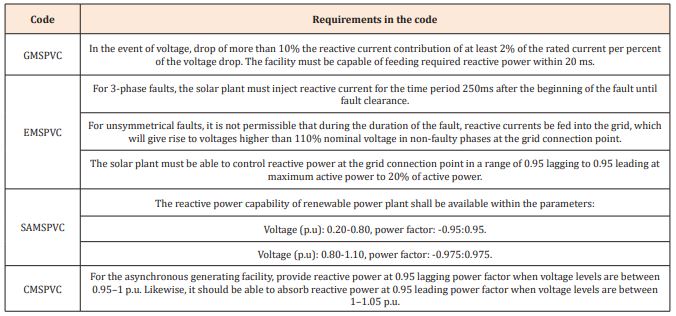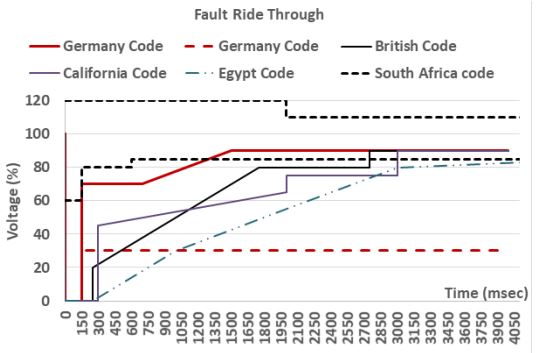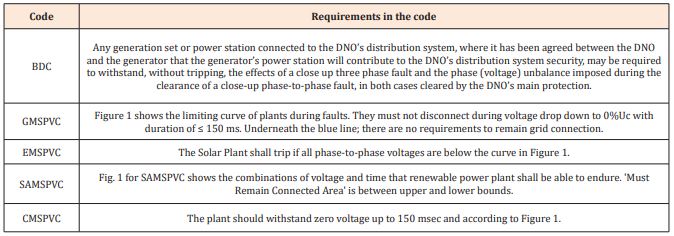Review of Electricity Distribution Codes and PV Connection Codes
Omar H Abdalla1*, Azza A A Mostafa2, Gamal Abdel-Salam3
1Department of Electrical Power & Machines, Helwan University, Egypt
2Department of Energy Effeiciency and Renewables, Egyptian Electric Utility and Customer Protection Regulatory Agency, Egypt
3Techncial Affairs Sectors, South Cairo Electricity Distribution Company, Egypt
*Corresponding author: Omar H Abdalla, Department of Electrical Power & Machines, Faculty of Engineering, Helwan University, Egypt
Article History
Received: August 14, 2021 Accepted: August 26, 2021 Published: August 27, 2021
Citation: Abdalla OH, Mostafa AAA, Abdel-Salam G. Review of Electricity Distribution Codes and PV Connection Codes. Int J Eng Tech & Inf. 2021;2(4):102‒107. DOI: 10.51626/ijeti.2021.02.00021
Abstract
Electricity is the key driver of the global economy. It is the prime energy resource for supplying customers (industry, irrigation, commerce, service, residence, etc.). This paper discusses technical requirements for Electricity Distribution Codes in various countries. The major similarities and differences between Electricity Distribution codes are clarified. Then, a detailed comparison of photovoltaic systems grid connection codes is presented. The comparison includes voltage and frequency deviations, active and reactive power control, power factor control and fault ride through.
Keywords: PV integration; PV code; Electricity distribution code
Introduction
Government programs in most of countries, are driving markets, creating opportunities for small businesses and delivering sustainable energy services. To achieve that, the network should be capable to ensure safe, secure and reliable operation. Distribution networks are the most confrontational to bidirectional flow challenge as most of businesses are small and medium scale renewable plants, which are connected directly to distribution networks. Therefore, Electricity Distribution code (EDC) and renewable codes should be updated to cope with these emerging challenges.
Detailed review of Egyptian Small-Scale Photovoltaic Code (SSPVC) and case study for a 200 kW photovoltaic (PV) plant was presented in [1]. An overview of various international standards for Low Voltage (LV) PV systems grid integration was presented in [2], showing the discrepancies between them. In addition, a comparison between Germany, France and Spain codes for Medium Voltage (MV) PV integration was presented. The current Vietnamese technical and administrative framework for connecting PV plants to the LV and Medium Voltage (MV) grids was examined in [3] including a comparison with the relevant Italian technical and administrative framework. European grid-code requirements for PV power plant installations to LV and MV is described in [4]. PV power integration related grid codes are collected and compared in [5] for different countries (China, Europe, North America). Detailed technical requirements for connecting solar power plants to electricity networks were presented in [6]. It included a brief comparison of solar power plants connection codes of Egypt, UK, Germany, and USA.
The structure of this paper is as follow: Requirements for electricity distribution codes in different countries are discussed in Section II. A detailed comparison of photovoltaic (PV) code in different countries is presented in Section III. Small scale PV Code is discussed in Section IV. Finally, main conclusions are summarized in Section V.
Electricity Distribution Codes
EDC regulates distributing and connecting electricity to customers. It also covers embedded generating units and transferring electricity between distribution systems. In this section, different EDCs are discussed including the British Distribution Code (BDC) [7], Saudi Arabian Distribution Code (SADC) [8], Egyptian Electricity Distribution Code (EEDC) [9], and Germany Medium Voltage Code (GMVC) [10].
A. Voltage range
The Distribution Network Operator (DNO) preserves the limits of the contracted nominal voltage change at supply point. Table 1 presents the operation voltage range in codes.
Table 1: Limits of operating voltage.
All codes defined operation voltage range with in ± 5 % for low voltage and medium voltage in EEDC; it is ± 10 % for aerial networks due to longer distances.
B. Frequency range
The DNO takes the necessary measures to preserve the network frequency, while taking into consideration the changes allowed within the grid code. Table 2 presents the operation frequency range in various codes.
Table 2: Limits of frequency operation.
The BDC and GMVC define the operation frequency range, but EEDC did not define the range, however it should follow the instruction of the National Control Centre.
C. Fault level consideration
The short circuit rating of user’s equipment at the connection point should be not less than the design fault level of the distribution network operator’s distribution system to which it is connected. Table 3 shows the necessity of not exced the short circuit level at the connection point.
Table 3: Short circuit rating of user’s equipment.
All codes clarify the limits of short circuit level at the connection point, which shall not exceed certain limits by the user’s equipment, and these limits are different according to the different construction of the networks.
D. Voltage phase unbalance
Voltage phase unbalance is defined as the ratio between the rms values of the negative sequence component and the positive sequence components of the voltage. Table 4 shows the limits of voltage phase balance in each code.
Table 4: Voltage phase unbalance.
The BDC and GMVC define the allowed percentage of voltage phase unbalance. EEDC defines the allowed percentage of current phase unbalance.
E. Power factor
The ratio of active power to apparent power is the power factor. Table 5 defined the power factor of the user.
Table 5: User’s power factor.
The GMVC allows the customer facility to be between 0.9 inductive and 0.9 capacitive. While EEDC obliged the customer to keep the average power factor at 0.90 but the exact billing is at average power factor 0.92 every three months [12].
Medium Scale Photovoltaic Codes
Medium Scale Photovoltaic Code (MSPVC) stipulates the technical requirements and specifications of integrating Medium Scale PV (MSPV) power plants to the medium voltage distribution networks. It should include technical requirements and limits of system performances such as frequency and active power control, voltage and reactive power control, and fault ride through. This section presents a comparison between British generating plant connection (BMSPVC) [13], Germany grid code for connecting PV systems to the medium voltage power grid (GMSPVC) [14], Grid connection code for renewable power plant connected to the electricity transmission system or the distribution system in South Africa (SAMSPVC) [15], Egyptian Solar Energy Plants Grid Connection Code (EMSPVC) [16] and California Requirements for Large Generator (CMSPVC) [17].
The Frequency and Active Power Control
The main reason for the active power control is to ensure frequency within range. Table 6 shows how the renewable station can help in controlling the active power.
Table 6: Control of active power for frequency regulations.
Reactive power control
Consumption and generating of reactive power must be matched in order to maintain a stable system voltage. Table 7 shows the contribution of reactive power to overcome voltage decrease.
Table 7: Reactive power contribution.
The GMSPVC mentioned that the facility must be capable of feeding required reactive power within 20 ms while the EMSPVC requires 250 ms of reactive current injection.
The range of reactive power within 0.95 leading to 0.95 lagging power factor at rated active power in medium voltage codes except for SAMSPVC.
Fault ride through
Fault Ride Through ability means that the grid-connected photovoltaic power station could remain online when the point of common coupling voltage is higher than the prescribed critical low voltage curve and lower than the critical high voltage curve during various faults and their clearance. Fault ride through is illustrated in Table 8, Figure 1.
Figure 1: Fault Ride Through for Germany, British, California, Egyptian and South Africa codes.
Table 8: Fault ride through.
Small scale photovoltaic code
Small Scale Photovoltaic Code (SSPVC) specifies the technical requirement for integrating small scale PV (SSPV) plant to the low voltage distribution network. In this section, the comparison includes the British small scale embedded generator connection PV (BSSPVC) [18], Germany Technical Conditions for the Connection to the low voltage network (GSSPVC) [19] and Egyptian Technical Requirements for Connecting Small Scale PV Systems to Low Voltage Distribution Networks (ESSPVC) [20].
A. Voltage Range
PV integration may increase the system voltage so it is so important to limit the maximum voltage. Table 9 presents the range of the voltage.
Table 9: Frequency range.
B. Frequency Range
PV that operates in parallel with utility system shall operate within the frequency limits. If the system frequency exceeds these limits, the PV system should disconnect until the system returns to normal frequency operation range. Table 10 presents the frequency limits.
Table 10: Voltage range.
C. Power Factor
According to power factor, the PV will inject or absorb reactive power to the network, which affects the voltage of the network. Table 11 presents the required power factor.
Table 11: Power factor.
Conclusion
Different codes from different countries have been reviewed. The requirements from each grid code are compared with each other and comments on major similarities and differences between them were given. Connection conditions for renewable power plants have been analysed and summarized for each grid code. Steady state or normal operations conditions such as voltage and frequency deviations, active and reactive power control, voltage control, and power factor control requirements were studied. Furthermore, fault ride through requirement during grid disturbance were covered.
References
- Omar H Abdalla, Azza AA Mostafa, Gamal Abdel-Salam (2019) Technical Overview of Connecting Small Scale Photovoltaic Systems in Egypt. Twenty First International Middle East Power Systems Conference (MEPCON). pp. 698-703.
- Mohamed EL-Shimy, Gamal M Hashem (2015) Overview of Grid Code and Operational Requirements of Grid-connected Solar PV Power Plants. Industry Academia Collaboration (IAC) Conference.
- ML Di Silvestre, Salvattore Favuzza, Eleonora Riva Sanseverino (2018) Technical Rules for Connecting PV Systems to the Distribution Grid: A Critical Comparison of the Italian and Vietnamese Frameworks. 2018 IEEE International Conference on Environment and Electrical Engineering and 2018 IEEE Industrial and Commercial Power Systems Europe (EEEIC / I&CPS Europe). p 1-5.
- Andres Honrubia-Escribano, Tania García-Sánchez, Emilio Gómez-Lázaro, E Muljadi, Angel Molina-García (2015) Power quality surveys of photovoltaic power plants: characterisation and analysis of grid-code requirements.” IET Renewable Power Generation 9(5): 466–447.
- Q Zheng, J Li, X Ai, J Wen, J Fang (2017) Overivew of grid codes for photovoltaic integration. IEEE Conference on Energy Internet and Energy System Integration (EI2). pp. 1-6.
- Omar H Abdalla, Azza A Mostafa (2019) Technical Requirements for Connecting Solar Power Plants to Electricity Networks. Innovation in Energy Systems – New Technologies for Changing Paradigms. pp. 1-27.
- http://www.dcode.org.uk/assets/uploads/DCode_010218_v29_1.pdf
- https://www.ecra.gov.sa/ar-sa/ECRARegulations/Codes/Pages/codes.aspx
- http://egyptera.org/ar/Code.aspx
- www.bdew.de
- http://egyptera.org/ar/SidePages/img/works/pdf/SitePDF/law2015.pdf
- http://egyptera.org/ar/Tarrif2020.aspx
- https://www.sseg.org.za/wp-content/uploads/2019/03/South-African-Grid-Code-Requirements-for-Renewable-Power-Plants-Version-2-8.pdf
- http://www.dcode.org.uk/assets/files/Qualifying%20Standards/ENA_EREC_G59_Issue_3_Amendment_7_(2019).pdf
- E Troester (2009) New German grid codes for connecting PV systems to the medium voltage power grid. 2nd International Workshop on Concentrating Photovoltaic Power Plants: Optical Design, Production, Grid Connection, Darmstadt.
- http://www.egyptera.org
- California ISO Frequency Response: Draft Final Proposal (Technical Report) (Folsom, CA: February 2016).
- http://www.dcode.org.uk/assets/files/Qualifying%20Standards/ENA_EREC_G83_Issue_2-Amendment_2_(2019).pdf
- http://www.ieapvps.org/index.php?id=15&eID=dam_frontend_push&docID=1048
- http://egyptera.org/ar/Code.aspx
- http://egyptera.org/ar/PeriodicalBooks2020.aspx
- http://works.bepress.com/omar/69/

